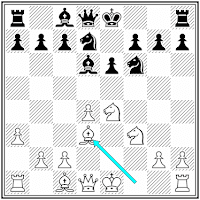I have been strungling for some time with a rather unorthodox line in the Euwe defense occuring after 1.d4 d5 2.e4 dxe4 3.Nc3 Nf6 4.f3 exf2 5.Nxf3 e6 6.Bg5 Bb4 7.Bd3 Nc6
Several experts have called 6...Bb4 a "weak" move, but to me it seems that the combined Bb4 and Nc6 is actually a very strong black defense. In fact, Houdini suggests the continuation 8.Qd2 with several black moves, such as 8...h6.
Is there no better white reply to 6...Bb4 than 7.Bd3 ? Scheerer surely does not mention anything else, but I believe the immediate 7.a3 is far better.
If black retreats 7...Be7, white has effectively won an important tempo after 8.Bd3 ( this move comes in handy against a potential 8...Nc6 )
If black captures 7...Bxc3 8.bxc3 then we effectively reach a position from the Winckelmann-Reimer gambit
For the interested, I can suggest the excellentr analysis at http://studimonetari.org/edg/latex/winckelmann.pdf
After 7...Ba5, white has an immediate continuation in 8.b4 Bb6 9.Ne4
Black's best reply now 9...Nbd7 can then be countered in various ways, the strongest being 10.c4 a6 11.c5 Ba7 12.Bd3 with an obvious white advanatge.
After 7...Bd6, the black bishop is misplaced somehow but it seems difficult to show any immediate white advantage, eg 8.Ne4 Nbd7 9.Bd3
Black's last try might be 7...h6, allowing the exchange 8.axb4 hxg5 9.b5 with complete equality
Bottonline : I believe 6...Bb4 is an important move that must be addressed carefully, since the standard 7.Bd3 Nc6 might not be easy for white. I believe 7.a3 ( in the spirit of the French Winawer ) gives white the better chances.






Dear Guido
ReplyDeleteExcellent stuff. I soon prepare a topic on my blog on thus subject. I have some informations. I will give you any of these.
Regards